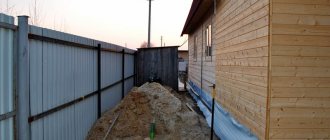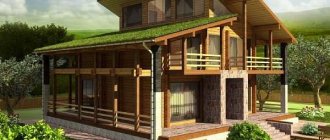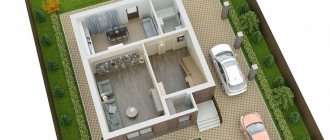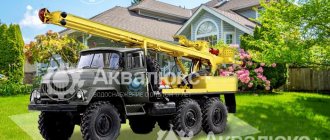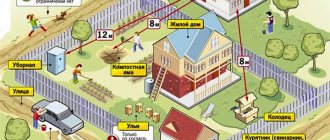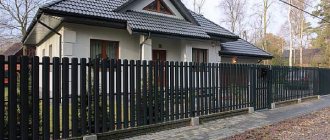Construction of a residential building is not only an expensive undertaking, but also a responsible one, since it must meet safety requirements, both during construction and during operation.
Gross violations of urban planning standards, as a rule, lead to the creation of dangerous situations in human life, therefore, such objects that violate them must be demolished according to the law.
Safe and sanitary living conditions should be provided not only for home owners, but also for their neighbors. To do this, the developer must strictly observe the permitted gaps between residential and auxiliary buildings on the site up to the boundaries with neighbors.
Why are standards needed?
Construction Norms and Rules (SNiP) is a basic state document in the field of urban planning, which outlines the rules that a developer must follow during the construction of any residential and non-residential facility.
It specifies standards for site allocation, design, selection of acceptable materials, construction, and acceptance of the facility into operation. A separate section of SNiP is devoted to the rules for the location of buildings, fences and green spaces on the site area.
It is important to take into account the following documents:
- SNiP 30-02-97;
- SNiP 2.07.01-89;
- SNiP 2.04.01-85;
- TSN-40-301-97.
Compliance with the requirements of SNiP is a guarantee that the house will last the entire required period, all the necessary sanitary and safe conditions will be created in it in terms of fire, energy efficiency and environmental standards, and the functioning of all house structures and utility networks will be trouble-free.
If the developer fulfills all the requirements of SNiP from allotment of the site to putting the house into operation, he will not be afraid of any disputes, including in court with neighbors and regulatory government bodies regarding the boundaries of the land plot and the location of objects on it.
Requirements for a gardening partnership
The charter of the partnership may provide its own parameters regarding the material and height of the fence. A reservation is allowed that the plots may not be fenced at all. The maximum height of the SNT street fence should not be higher than 2.5 meters. The material of construction is not particularly important.
The structure must be of sufficiently high strength. The bases are firmly installed in the ground and, if necessary, strengthened with additional clamps. Fences that allow light to pass through are installed between adjacent areas.
If you want to make a structure higher than 2.5 meters, you must obtain permission from the housing department of the local administration. A solid fence is allowed to be installed only on the street side. The height of the fence between neighboring plots should not be higher than 2 meters.
- If houses and outbuildings are located close together, it is allowed to partially overlook the neighbor’s property along the boundary. But this is prescribed in the agreement, which is approved by a notary.
- Access to a neighbor's property should not interfere with access to communications, passage and travel. One-way transfer of the fence is prohibited. When carrying out installation, specialists must take into account the parameters of the site and not go to the neighbor’s site, taking away their territory.
- If a house is partially built on a neighbor's property, it may be demolished. But with a minimal error, neighbors can agree on compensation and end the matter with a settlement agreement.
During legal proceedings, construction and technical expertise will be required to prove that the fence was actually built with violations and violates the rights of neighbors.
- It is possible to reach an agreement without the intervention of judicial authorities. But if there are obvious significant violations, the neighbor may lose the fence and the entire building as a whole - especially if it was erected along with the fence on an unauthorized basis.
- The examination must be ordered at the plaintiff’s expense. If he wins the case, he has the right to recover legal costs from the defendant, including the costs of expert services.
- Before starting work, you should draw up a detailed project, check it for compliance with SNiP standards and entrust the construction of the house to reliable craftsmen.
It is advisable to order all services strictly under a contract or paid provision of construction services. Controversial issues should be resolved through negotiations or in court. The claim is filed at the location of the property. It is possible to involve witnesses and competent specialists in the case.
List of documents
Since the area covered by the regulations is huge, from the start of construction to commissioning, it is regulated by several dozen regulations.
In order for the developer to easily navigate this package of regulations, specialists have prepared a Code of Rules (SP) for certain objects. In 2021, SP No. 55.13330 was issued for residential households, and similar sets of rules have been prepared for other construction projects.
It is important to consider the following standards :
GOST 27751-2014;- GOST 30494-2011;
- GOST R 53780-2010;
- SP 1.13130.2012;
- SP 4.13130.2013;
- SP 7.13130.2013;
- SP 30.13330.2016;
- SP 32.13330.2012;
- SP 256.1325800.2016;
- SanPiN 2.1.2.2645-10;
- SP 11-106-97;
- VSN 59-88;
- RDS 30-201-98;
- SanPiN 2.1.4.027-95.
Such standards have been updated with recent changes in legislation to increase the safety of people in buildings and protect property in accordance with the requirements :
- according to technical safety regulations;
- sanitary and epidemiological standards;
- fire safety and energy efficiency.
This Code of Rules must be applied when performing design, research, and construction work for houses with no more than three storeys.
They separately highlight sections on obtaining technical specifications for connecting engineering and transport infrastructure, rules for the location of sites and the placement of objects within the boundaries of the land plot, taking into account the requirements of fire and sanitary and epidemiological safety for living conditions.
There is also a separate section in connection with which the developer, during the construction process, must carry out the necessary set of measures to protect the environment from threats that may arise during the construction process or during the operation of the facility, for example, when installing utility networks or placing cesspools.
Types of sites and permissible buildings
The minimum distances between buildings may depend on the type of land plot. Ownership of different types of property does not always provide the same opportunities for the owner’s construction activities. Therefore, you should be guided by documents related to the specific type for which you have rights and documents:
- Individual housing construction assumes the possibility of construction for permanent residence and disposal of the site for the construction of buildings necessary for residents (the owner can decide what to build, and how to build - the relevant documents);
- you can simply relax on your summer cottage; you don’t have to build a house, but if you do build it, it will be done according to existing standards;
- The construction of permanent structures is prohibited on agricultural plots; only outbuildings are allowed;
- On a personal plot, except for a house no higher than three floors, farming must be carried out;
- In a gardening community, planting is mandatory, and houses can be built seasonally.
The distances between buildings erected on different types of land owned may vary depending on the regulations adopted for this type of land ownership.
Compliance with the prescribed standards is mandatory for both the owner and the tenant, since they are dictated by practical considerations.
Layout of buildings
The advisability of moving away to a certain distance is to comply with fire and sanitary safety, the legal rights of people living on both sides of the boundary. In case of non-compliance with rules and regulations, neighbors have the right to file complaints or lawsuits with the appropriate authorities.
The procedure for constructing a private cottage
Minimum distances between objects are established by three departments:
- construction;
- firefighters;
- sanitary.
Many building rules and regulations were developed back in the Soviet period, some of them are still in effect without changes, and some have been updated to meet modern requirements.
Development in the individual sector is regulated by the requirements of SP 30-102, 1999 edition, and the location of the construction site on the site in relation to its boundaries and the red line of urban facilities is regulated.
SP 30-102 also specifies fire and sanitary standards for private housing construction, which are reflected in the development plan and other design documentation when exposing buildings on a land plot.
Fire regulations
Such distances are established by the Law of the Russian Federation No. 123, issued on June 22, 2008, and Fire Safety Standards No. 106, issued in 1995.
They are aimed at ensuring that fire safety gaps between houses are maintained, so that in the event of a fire at one facility, the fire does not damage nearby buildings, and special equipment can also pass through to extinguish fires and there is the possibility of installing hoses and access to extinguishing fires.
Minimum fire distances between objects in the storage area:
- From auxiliary premises to the fence: utility block, gazebo, garage and bathhouse, 1 m, barn for animals and poultry, 4 m.
- From the toilet in the individual housing construction zone, 1 m.
- From the toilet in the SNT zone, 2 m.
- House of DNP, individual housing construction and SNT, 3 m.
- Shrub, 1 m.
- Medium tree, 2 m.
- Tall tree, 4 m.
- Between two neighboring households:
- wooden - 15 m;
- wooden and stone - 10 m;
- both stone - 6 m;
- with wooden floors - 8 m.
- From a stationary barbecue to any object - 5 m.
- From a warehouse with a flammable substance: liquefied gas, diesel fuel to any object - 10 m, from an adjacent 3-meter zone without grass and trees.
- From the road to the house and the bathhouse - 5 m.
- From the forest area to the house - 15 m.
Homeowners should not use fire clearances for any business purposes, such as storing equipment, building materials and parking. They must keep this area clean and remove grass and weeds in a timely manner. It is also prohibited to light fires or burn waste in these areas.
Sanitary requirements
Sanitary restrictions are aimed at ensuring sanitary and hygienic living standards for protection from harmful emissions, for example, from a chimney or sewer, and ensuring a sufficient level of illumination of the territory and its noise protection.
Minimum sanitary gaps between objects from the boundaries of the landfill:
- Residential property, 3 m.
- Barn for livestock and poultry, 4 m.
- From the house to the bathhouse: wooden - 12 m, stone - 8 m.
- From a residential building to an animal barn, 15 m.
- From a residential building to a well or toilet - 8 m.
- From the toilet to the well, 8 m.
- From the toilet and cellar, 12 m.
- From the fence to the treatment plant, 1 m.
- From the compost pit and well, 8m.
- From any building to the gazebo, 4m.
The procedure for setting the distance: in the case when the roof of the house extends beyond the cut of the load-bearing wall by less than 0.5 m, the distance is measured along the foundation, otherwise it is measured according to its projection onto the ground. This is due to the fact that precipitation from the roof cannot enter the neighboring territory.
Summing up communications
Construction of utilities begins with obtaining specifications for laying networks from service providers :
- water;
- sewerage;
- gas;
- heating and electricity.
In the technical specifications, the supplier must indicate the insertion point and parameters of utility networks.
Based on the specifications, a house design is carried out with a section on engineering networks, which contains graphic materials in the form of drawings and laying diagrams with clarification of the maximum distance for each type of network.
Electricity supply
The distance of electrical networks is determined by the Electrical Installation Rules (PUE):
- Electrical wires from the street pole to the subscriber input of a residential building must be installed at a height of at least 2.75 m from the ground level.
- For a branch that is powered from another street and crosses the road, a minimum height of 6 m is established; in this case, an auxiliary support is placed at the border of the site at a distance of up to 15 m.
- The length of the branch line from the main support should not exceed 25 m.
All areas where wires and cables touch the surfaces of the house, as well as passage through walls, are made with fireproof materials and are reliably insulated. At the entry point, the outer end of the insulating pipe should be directed downward to prevent precipitation from entering it.
Gas supply
The procedure for installing gas supply networks is established by SNiP 2.04.08, published in 1987. It clearly defines the place where the gas pipeline enters the house - from the kitchen or furnace room. For old households with stove heating, gas entry is allowed through the room, provided that an external shut-off valve or valve is installed.
When laying a pipe along the outer wall of a building, its maximum diameter cannot exceed 50 mm. All connections must be welded; when crossing pedestrian paths, they must be placed at a height of at least 2.2 m from the ground.
Minimum distances when laying a gas pipeline:
- From the underground gas pipeline to the foundation of the house:
- D<300 mm P up to 0.005 MPa - 2 m;
- P < 0.3 MPa - 4 m;
- P = 0.3 - 0.6 MPa - 7 m.
- The distance from the above-ground gas pipeline to the house is not standardized; compliance with the condition of the intersection of the pipe with windows and doors above 0.5 m, and for the roof below 0.2 m is checked.
- Permissible distance from the gas main P = 0.3 - 0.6 MPa:
- road - 7 m;
- water supply - 1.5 m;
- sewerage - 2.0 m;
- electrical network - 5 m.
- Security zone of 2 m on each side of the low pressure gas pipeline.
Water supply
Water supply on the site can be centralized and autonomous: from wells and springs, through a receiving storage tank, while the pressure in the supply pipeline must be at least 0.1 MPa.
Minimum distance from existing water supply:
- The distance to the foundation of the house is 5 m; in cramped conditions this figure can be reduced to 1.5 m when using steel and polymer pipes.
- At least 3 m from fences.
- From a tree trunk with foliage D=5 m - 2 m.
- Location from other utility networks:
- height above the sewer not less than 0.4 m;
- the step between two water lines is 1.5 m;
- between sewers from 1.5 to 5 m depending on the diameters.
- The location of water wells to the foundation of the house is at least 15 m.
The location of water wells should be at least 50 m away from places of possible contamination: landfills, cesspools, fuel and lubricants storage.
Sewerage
These networks, as a rule, in adjacent areas are gravity-fed, and if violations are made during pipe laying or operation, flooding of the territory or even residential premises will occur.
To ensure that neighboring territories and sanitary-protected facilities are not contaminated, the minimum diameter of the external sewer system is accepted as 100 mm, with a guaranteed slope of 8% in relation to the general collector, while the minimum level in the ground should be 0.3 m.
Minimum clearances from the sewer pipe to the foundation of the household:
- pressure gasket - 5 m;
- household gravity - 3 m;
- rain or storm drain - 3 m;
- drainage - 3 m;
- accompanying drainage - 0.4 m.
Existing standards and their conditionality
The SNiP standard in 2021 provides for the need to demarcate neighboring areas after taking their measurements and confirming their correctness with ownership documents.
This means that the construction of a fence is one of the mandatory measures to preserve the integrity of the land plot.
However, this does not mean that the site can be limited by a fence of any type. For example, a solid fence three meters high and additionally equipped with piercing, cutting or damaging objects.
The fence parameters are also advisory in nature. Even if the SNT charter provides for a one and a half meter high fence between neighbors with 50% transparency, then upon receipt of a written agreement certified accordingly, a solid fence can be built. Or a higher one, at the same time ventilated, but invisible to prying eyes due to the peculiarities of the construction.
Standard distances
Compliance
Any structure on a plot of land must comply with certain standards dictated by extensive experience in general and individual construction. An approximate list of requirements for any type, from a residential building to an outdoor toilet, is as follows:
- Compliance with generally accepted fire safety rules in SNT or individual housing construction. Now this responsibility is within the competence of the owner of the house or building, since the state has decided that this is in his interests. Thus, it saved budgetary funds on the work of employees of special bodies and forced the owner to independently take care of protecting his structure from fire.
- Environmental standards: buildings should not be constructed from toxic materials that can harm the environment, the inhabitants of a particular house or people living nearby. This applies to residential buildings and any ancillary buildings equipped for household needs.
- Mechanical standards provide for quality construction of any type of construction. The obtained result should not pose a danger of collapse or injury due to insufficiently complied with the standards of technical or functional compliance of the constructed building or device.
- Sanitary standards apply to cesspools or compost pits, outdoor toilets, showers and baths. The same applies to their distance from a water source or water pipeline, garbage removal and equipment of special containers, and elimination of a potential source of infection.
- Climatic correspondences. Any building should not pose a danger to others in adverse weather conditions. This requirement is especially taken into account in places with harsh climates with potential earthquakes, hurricane winds, heavy rains, etc.
Buildings for any purpose, be it a residential building or a temporary shed for storing tools, are essentially required to comply with one condition - the absence of infringement on the rights of any person living nearby.
Standards for placing buildings in the yard
The same applies to the rights to safe movement, guaranteeing fire and sanitary safety standards, environmental friendliness, and absence of interference. This is why the distance to the neighbor’s fence in the private sector is so important.
Development relative to the red line
The red line (RL) is a symbol of the boundary of the landfill, located between it and the road or other municipal or urban infrastructure facilities.
What needs to be taken into account according to SNiP when erecting any buildings on a site relative to the red line:
- The placement of a residential building is at least 5 m from the street line, and from the roadway at least 3 m.
- The interval from outbuildings to cable lines of streets and driveways must be at least 5 m.
Houses located on opposite parts of the driveway must take into account fire breaks. It is possible to build a garage directly adjacent to the fence, if there is appropriate approval from the board of the dacha or garden association.
The user, when using the allocated land plot, should never go beyond the red line. If regulatory authorities in the field of land use find that the owner is violating the red line, he may be held administratively liable , a fine may be imposed on him in court, and the controversial object will most likely be demolished.
Border with neighbors
, the following gaps must be observed between neighboring objects :
- Between neighboring houses 6 - 15 m.
- From the toilet to the neighbor's household - the size of the plot is 12 m.
- From the compost pit to the neighbor’s household - 8 m.
- Drinking well to neighbor's property - 8 m.
- Garage to any neighboring building - 6 m.
Fence height
The fence, despite its simple appearance and design, is not so simple from the point of view of standards; its installation is regulated by SNiP No. 30-02, the updated version was released on March 12, 2001. The main requirements for the appearance of the fence are unhindered access of sunlight to the neighboring area , so it must have a transparent fence: mesh or lattice.
Also for these reasons, the standards limit the height of the fence to 150 cm . It is possible to change this height by agreement with the neighbors, but these agreements must be recorded in writing in the form of an agreement, so that if the neighbor suddenly changes his mind, the owner would not have to redo the fence.
Based on practice results, it is recommended to make external fencing no higher than 2 mm with transparency higher than 50%.
Environmental restrictions
These standards are aimed at protecting water, land and forest resources from possible negative factors that may arise on the land user's site.
These include:
- fires;
- soil and water pollution.
Based on this, SNiP No. 30-02, dated 1997, established the norm for the location of buildings from the border of the forest area over 15.0 m.
The protection of water resources is regulated by the Water Code. In this case, the requirements for the safe design of water supply and drainage systems must be met. Certain restrictions on the use of coastal areas have also been introduced regarding the location of compost pits, animal sheds, fertilizer storage and the organization of recreation areas. Any coastline 20 m wide is protective.
Standards for building a house on an individual housing construction site: indentations 2021
When constructing various real estate objects, the distance is regulated by legislative documents. The house design developed by the builders is approved at the level of local authorities and is calculated in direct relation to the parameters and number of floors.
Accurate measurements
The easiest way to decide is with low-rise buildings, where legal distance values are clearly developed and approved. It is allowed to erect buildings in accordance with regulatory requirements, with a distance of up to three meters, provided that there is more than 5 meters to the house on the neighboring plot.
The undeveloped nature of the neighboring land allows us to be guided by three meters as the norm, and then the neighbor will have to comply with the norm of 6 m from the windows of the residential structure to the wall of the building that he will build.
Diagram of distances from the fence to buildings according to SNiP and SanPiN standards
It does not matter what kind of structure it will be: in accordance with sanitary standards, any building must be located at a 6-meter distance so as not to interfere with the use of a neighbor already located at the required distance from the living space.
Differences in the principles of development on individual housing construction and in SNT
These two organizations have a different legal basis: individual housing construction is an individual housing construction with the right of permanent residence in a household of up to 3 floors, and SNT is a gardening non-profit partnership for gardening and vegetable farming, without permanent residence.
In SNT, for a plot of 6-12 acres, it is allowed to develop no more than 30% of the land area and only strictly according to the land plan.
Minimum distances for individual housing construction objects:
- from the base to the border of the adjacent landfill at least 3 m;
- from the animal shed to the border of the neighboring property is at least 4 m;
- from economic objects to the border of the neighboring land plot is not less than 1 m, if less, then the roof slope is directed towards the personal land plot;
- from tall trees to the border of the neighboring land plot is no less than 4 m, medium trees - 2 m, and bushes - 1 m.
In order to correctly carry out measurements, the calculation is performed from protruding elements of the building or from the base.
Minimum distances for SNT objects:
- from the house to the fence at least 3 m;
- from barns for livestock and poultry at least 4 m;
- personal buildings of at least 1 m;
- bushes at least 1m;
- medium trees at least 2 m;
- tall, at least 3 m;
- a garage can be built on the border of the site.
Minimum setbacks from the boundaries of the land plot
Previously, the owner could retreat 1 m from the edge of his property (if a one-story house was being built). Sometimes incompetent builders even today advise owners to make such a distance in order to save land. However, it is household gaps (the distance of window openings of residential premises from the wall of any building, even if it is unheated) and fire requirements that are clearly provided for in the relevant law.
At the summer cottage
According to the standards for 2021, you cannot approach the fence more than 3 m, even if the area is less than 12 m wide. It should always be determined by the prescribed distance from someone else's home.
Compliance with removal during the construction of a house on a site where there are no other structures yet is regulated by an individual plan-scheme approved in advance. It takes into account all the buildings on the other side, behind the fence.
If there is empty land there, you can safely make a minimal indentation, and then the new neighbor will have difficulties with the location of the buildings. If the fence is located on the street side, the distance from the red line is taken into account. In this case, the maximum distance standards depend on what is behind the fence - a driveway, a roadway or a busy highway, but the minimum possible is 5 m.
Location of buildings on individual housing construction and SNT sites
Conditions for the construction of a second residential building on a land plot
It is very important to maintain the correct distances when building a second household on the site. There is no direct prohibition on the construction of such an object by law, however, when legalizing the structure, problems may arise due to violation of the minimum gaps.
The standards for the construction of a second home are related to the maximum permitted percentage of development , as well as the smallest gaps between the house and the boundary of the land plot. These data are determined by the city municipality, so these indicators may differ significantly for each locality.
In order to find these readings, you need to go to the website Rules for land use and development of a specific area, for example, the Moscow region. The archive contains a Town Planning Plan or Zoning Map, the Rules indicate the maximum percentage of development of 40% and the setback from each household to the boundaries of the land plot is 3 m.
For land of 6 acres, two houses (without other buildings) should have an area of no more than: 600X0.4:2 = 120 m2 , and the distance between them should be 6 m. If additional utility facilities are built, the area of the houses should be reduced accordingly.
Risks of non-compliance with the rules
Building your own home today is a very expensive undertaking; it must be done correctly, starting with the design of the site, so as not to lose all the money spent.
Strict compliance with building standards when constructing objects on a personal plot is to protect the owner from emergency situations in the house, from claims from neighbors and regulatory authorities.
The owner of a residential building who violates the boundaries of his property and the interests of his neighbors may incur civil and administrative liability . According to the first option, the house can be demolished at his expense, and if he does not do this voluntarily, then the site will be seized, in accordance with the requirements of Art. 285 of the Civil Code of the Russian Federation.
Administrative liability for violations is determined by Art. 9.5 of the Code of Administrative Offenses of the Russian Federation, implies the imposition of penalties from 1.5% of the price of the storage unit, but not less than 2,000 rubles. for violation of construction, fire and sanitary legislation, and if they caused harm to human health and the environment - 4,000 rubles.
Neighbors affected by the illegal actions of the owner can apply to the court with an independent claim for the demolition of the illegal building, to the prosecutor's office and the administration with a corresponding complaint.
Procedure at the initial stage of construction
It would be a mistake to believe that, having become the owner of his own plot, a person has the right to carry out chaotic development, not paying attention to the distance from the neighbor’s fence. The specificity of using a land plot is that the boundary is not the ultimate boundary of property, but rather a conditional demarcation from which one should deviate:
- There is a neighboring plot behind the constructed fence, and placing it close to it implies a violation of the rights of the owner, whose property is located behind the fence.
- You may receive variable complaints from neighbors regarding damage to the fence from trees and shrubs, pollution and unpleasant odors from sanitary facilities.
- If a shadow falls on a neighboring property, they may file a lawsuit for damages due to the shade of the beds.
- Non-compliance with standards can lead to wastewater entering other people's property, which always causes legitimate dissatisfaction, and this means the risk of administrative liability or fines from supervisory organizations.
- The required distance is not measured arbitrarily, but in accordance with the requirements, taking into account the premises on the neighboring property, and not only your own fence.
Standards
Therefore, a thorough planning of the owned land plot is carried out. The drawn up scheme is certified by the authorities exercising control. If future development does not comply with setback standards or is located at a distance that is prohibited by a certain standard, adjustments are made to the drawn up plan. From a certain time, approval of the plan is included in the list of mandatory events, immediately after the demarcation and construction of the fence.
Pre-planned placement of buildings not only satisfies legal requirements, but also respects the interests of the owner himself. After all, moving incorrectly located objects is much easier to do on a diagram than to do this when we are already building or have completed construction.
SNiP standards
After obtaining permission, you can begin marking out the adjacent areas (immediately after the main object - individual housing construction - is determined). In 2021, they can also be built on a summer cottage, the standard dimensions of which are almost always small.
Building regulations here are checked especially carefully, but they can be slightly circumvented if you have the appropriate permission.
